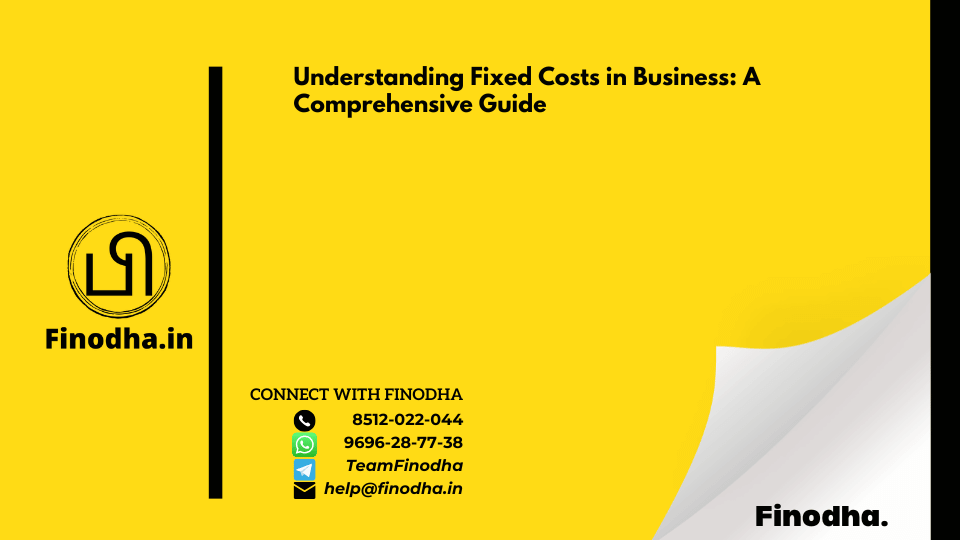Important keyword: Fixed Costs, Managing Fixed Costs, Important of Fixed Costs, Fixed vs Variable Costs.
Table of Contents

Introduction to Fixed Costs
Fixed costs represent one of the fundamental components of a business’s financial structure. Defined as expenses that do not change with the level of production or sales, fixed costs remain constant over a specified period, regardless of a company’s output fluctuations. These costs form a base level of expenditure that businesses incur to maintain operations, making it crucial for business owners and managers to comprehend their implications on overall financial health.
In contrast to fixed costs, variable costs fluctuate directly with production volume. For instance, a bakery might incur fixed costs such as rent, utilities, and equipment depreciation. Regardless of whether the bakery produces ten loaves of bread or one hundred, these expenses remain relatively stable. In contrast, the costs associated with flour, sugar, and other ingredients exemplify variable costs, as they increase or decrease based on the bakery’s level of production. This distinction emphasizes the importance of understanding fixed costs when managing a business’s budget and forecasting future financial performance.
The significance of proficiently managing fixed costs cannot be overstated. Maintaining a solid grip on these expenses allows business owners to navigate periods of fluctuating demand more effectively. A bakery, for instance, may experience seasonal fluctuations in orders—knowing the fixed costs aids in planning for cash flow shortages during lean periods. Additionally, understanding the proportion of fixed costs to total expenses can guide strategic decisions, such as pricing strategies and expansion plans.
In summary, grasping the concept of fixed costs is crucial for any business aiming to enhance financial stability and operational efficiency. By distinguishing fixed from variable costs, entrepreneurs can develop informed strategies for better financial management, aiding in long-term sustainability and profitability.
Understanding Fixed Costs in Management Accounting
In the realm of management accounting, fixed costs play a pivotal role in shaping financial strategies and operational decisions. Fixed costs, which remain constant regardless of the level of production or sales, offer a unique perspective for financial forecasting. For organizations, understanding these costs is vital for budgeting and forecasting cash flow, as they allow for a more structured financial plan. By distinguishing fixed costs from variable costs—those that fluctuate with production volume—financial managers can create accurate financial models that predict future expenditures and revenues.
Notably, the categorization of fixed and variable costs influences a business’s pricing strategy. For instance, recognizing fixed costs aids management accountants in identifying the break-even point of a product or service. This knowledge enables them to establish pricing levels that not only cover these fixed costs but also ensure profitability. Moreover, effective marketing strategies can be devised based on this comprehension, as understanding fixed costs helps delineate the costs associated with marketing activities and customer acquisition.
Financial executives leverage insights derived from fixed cost analysis to inform their strategic decision-making processes. This understanding empowers them to evaluate the impact of changes in production levels on overall cost structures and profitability. For example, if fixed costs are unchanged while variable costs decrease, a company can enhance its margins. Additionally, insights into fixed costs assist in resource allocation, ensuring that capital is allocated efficiently to support long-term operational effectiveness.
In summary, fixed costs are integral to management accounting. They provide essential information for financial forecasting, help shape pricing strategies, and support decision-making processes for better financial performance. A comprehensive grasp of fixed costs allows businesses to thrive in competitive markets by tailoring their strategies in line with both fixed and variable cost dynamics.
The Nature of Fixed Costs
Fixed costs are often characterized by their apparent constancy over a specified period. These costs, which include expenses such as rent, salaries, and insurance, remain unchanged regardless of the level of production or sales. However, it is essential to acknowledge that these costs are not entirely static. Various factors can lead to changes in fixed costs over time, transforming them into more dynamic components of a business’s financial structure.
One significant factor influencing fixed costs is contractual obligations. Certain fixed costs are predetermined by contracts that stipulate the payment terms for facilities, labor, or services. If a business enters into a new rental agreement or renegotiates an existing contract, the terms can result in higher or lower fixed costs. Additionally, during periods of economic volatility, businesses may face unforeseen expenses that can elevate fixed costs. For example, a company may need to invest in additional equipment to maintain operational efficiency, thereby increasing its fixed cost base.
It’s also important to differentiate between short-run and long-run fixed costs. In the short run, fixed costs are typically considered invariable, as they remain constant irrespective of output levels. However, in the long run, businesses often encounter adjustments that may alter their fixed cost structure. As a business grows or scales down, it may acquire new assets, change its location, or modify its staffing levels—all of which can influence fixed costs in the long run.
Understanding the nature of fixed costs requires a nuanced perspective that recognizes the potential for change. While they may be viewed as stable, a thorough analysis indicates that they can evolve based on various internal and external factors, shaping the overall financial landscape of a business.
Examples of Fixed Costs in Different Industries
Fixed costs are integral to the financial structures of various industries, demonstrating how businesses can operate within their defined economic parameters. They remain constant regardless of the level of production or sales. Let’s examine fixed costs in three diverse sectors: manufacturing, retail, and services.
In the manufacturing industry, fixed costs typically include expenses such as rent or mortgage payments for factory space, salaries of permanent employees, depreciation of machinery, and equipment costs. For example, an automotive manufacturer invests significantly in sophisticated machinery that remains a fixed cost for years, despite fluctuations in vehicle production. Similarly, lease agreements for production facilities lock these manufacturers into specific financial commitments, regardless of output levels, underpinning the necessity of managing fixed costs adeptly.
In the retail sector, fixed costs can take on several forms, including rent for storefront locations, salaries for administrative staff, and ongoing utilities. A retail chain, for instance, incurs consistent monthly expenditures such as lease payments for its various retail units. Even if sales dip due to seasonal trends or economic downturns, these costs persist, necessitating effective inventory and pricing strategies to maintain financial health. Furthermore, operational costs—like security services or insurance premiums—add to the fixed cost obligation retailers face.
Turning to the service industry, fixed costs may involve salaries for full-time staff, office rent, and technology investments. Take a consulting firm, for example; it incurs fixed costs associated with maintaining office facilities and compensating its permanent employees. These commitments remain constant irrespective of the number of clients served or projects completed in a given period, highlighting the importance of strategic financial planning.
As evident, while fixed costs manifest differently across these sectors, the core principle of being unaffected by production or sales levels remains consistent. Understanding these costs is crucial for businesses to effectively manage their financial strategies and enhance profitability.
Discretionary vs. Committed Fixed Costs
Fixed costs in business are generally classified into two categories: discretionary fixed costs and committed fixed costs. Understanding the distinction between these two types is crucial for effective financial planning and management. Discretionary fixed costs, as the name suggests, are expenditures that can be altered or eliminated without significantly affecting the company’s operations. These costs typically relate to non-essential activities and projects, such as marketing, training programs, or research and development initiatives. For instance, a company may choose to invest in a new marketing campaign to enhance brand visibility. However, if budget constraints arise, it can easily decide to postpone or scale back such expenditures.
On the other hand, committed fixed costs are those expenses that are largely inflexible and mandatory. These costs stem from pre-existing commitments made by a business, such as leases, salaries, and utility contracts. Committed costs must be absorbed by the business regardless of changes in revenue or sales activity. For example, if a company has signed a long-term lease for office space, it is obligated to pay that rent, irrespective of its operational performance in a given period. Such commitments can significantly impact a firm’s financial stability, emphasizing the need for careful long-term planning.
Effectively managing both discretionary and committed fixed costs can lead to a more sustainable financial framework. Businesses should regularly review discretionary expenses to identify potential savings without jeopardizing their overall strategic goals. In contrast, committed costs require careful evaluation at the time of signing contracts or agreements. This dual approach ensures that a business can remain flexible in its operations while also meeting essential financial obligations, ultimately fostering a healthier economic environment.
The Financial Impact of Fixed Costs on Business Operations
Fixed costs represent a significant component of a company’s overall expense structure. These costs, which do not change with the level of goods or services produced, include expenditures such as rent, salaries, and insurance. Understanding the financial implications of fixed costs is essential for effective business management, particularly as it relates to profitability and strategic decision-making.
High fixed costs can place pressure on a business, particularly during periods of fluctuating sales and revenue. When sales volume decreases, fixed costs remain unchanged, leading to a reduced profit margin. This phenomenon can create a precarious financial situation where a company with high fixed expenses may struggle to cover these costs, ultimately affecting its operational viability. Consequently, businesses must monitor their fixed costs closely and manage them effectively to maintain profitability.
The presence of significant fixed costs also influences a company’s pricing strategy and market competition. In an attempt to cover constant expenses, firms may increase prices during low sales periods, potentially alienating customers and harming overall business performance. Additionally, companies may find themselves constrained in their growth strategies, as engaging in expansion activities—such as capital investment in new projects—requires careful consideration of existing fixed costs. The balancing act between maintaining a competitive edge and managing financial obligations remains a vital aspect for businesses with high fixed cost structures.
Moreover, effective forecasting and budgeting practices become crucial for businesses operating under a fixed cost paradigm. Companies must assess their revenue streams and predict future sales scenarios to ensure they can accommodate these unavoidable expenses. Encouraging flexible business practices and diversifying revenue sources can also help mitigate the financial risks associated with fixed costs, allowing for improved resilience in a fluctuating market environment.
Strategies for Managing Fixed Costs
Managing fixed costs is essential for businesses looking to maintain financial health and ensure sustained profitability. One effective approach is to renegotiate contracts with suppliers and service providers. By initiating discussions about pricing, payment terms, and volume discounts, businesses can often secure more favorable conditions that reduce overall fixed expenditures. This renegotiation process is not just about lowering costs; it may involve lengthening contract terms or switching to more flexible arrangements that allow for eventual scaling of services as the business grows.
Another important strategy involves optimizing resource allocation. Businesses should regularly assess their fixed assets and staffing levels to ensure that resources are utilized efficiently. For instance, unnecessary leases on office space or outdated equipment can lead to inflated fixed costs. By consolidating operations or considering remote work arrangements, companies can reduce overhead without diminishing productivity. Additionally, analyzing the performance of various departments can help identify areas where resources can be reallocated to maximize their impact.
Implementing technology is also pivotal in managing fixed costs. Automation tools and software solutions can streamline operations, thereby reducing labor costs and minimizing human error. For example, employing inventory management systems can help businesses better align their supplies with demand, thereby reducing the fixed costs associated with overstocking or wastage. Furthermore, leveraging cloud-based solutions can cut down on the need for expensive hardware and maintenance, translating to long-term savings.
In conclusion, effectively managing fixed costs requires a multifaceted approach that combines contract negotiation, resource optimization, and technological advancement. By adopting these strategies, businesses can maintain control over their fixed expenses and enhance their overall financial stability.
Forecasting Earnings with Fixed Costs
Understanding fixed costs is fundamental in the realm of business forecasting, particularly when it comes to projecting future earnings. Fixed costs, which remain constant regardless of the level of production or sales, play a pivotal role in overall financial performance. Companies must grasp how these expenses interact with variable costs and their influence on profitability. Accurate forecasting of earnings involves analyzing how changes in unit sales affect the financial landscape, taking into account the presence of fixed costs.
One prevalent method used to quantify the impact of changes in unit sales on earnings is the break-even analysis. This analysis determines the sales volume at which total revenues equal total costs, identifying the point at which a business begins to generate profit. By focusing on fixed costs, businesses can ascertain how many units need to be sold to cover not only the variable costs but also the associated fixed costs. Understanding this equilibrium can provide valuable insights into the operational efficiency of the business and assist in setting realistic sales targets.
Furthermore, businesses can leverage forecasting techniques, such as sensitivity analysis, to assess different sales scenarios and their potential impact on earnings. By modeling various situations related to fixed costs and unit sales fluctuations, companies can gain a comprehensive understanding of their financial dynamics. An effectively executed financial plan that incorporates these considerations enables organizations to allocate resources more efficiently and make informed decisions. Consequently, comprehending fixed costs is vital for effective budgeting and financial planning, allowing businesses to navigate uncertainties and capitalize on potential growth opportunities.
Conclusion: The Importance of Fixed Costs in Business Strategy
In the realm of business management, understanding fixed costs is pivotal for sound financial planning and strategy development. Fixed costs, which remain constant regardless of production levels, play a significant role in determining a business’s financial health. Recognizing how these costs impact overall expenses and profitability aids leaders in making informed decisions. A business’s ability to manage fixed costs effectively can be a critical determinant of its success or failure.
Throughout this discussion, we have highlighted the fundamental aspects of fixed costs, including their nature, examples, and the implications they have for cash flow management. The ability to differentiate between fixed and variable costs is essential, as it enables businesses to allocate resources judiciously. Additionally, understanding fixed costs helps in forecasting future expenses, setting pricing strategies, and establishing budgets.
Furthermore, a regular evaluation of fixed costs should be integrated into broader financial strategies. Business leaders are encouraged to periodically review their fixed cost structures to identify potential areas for optimization. This ongoing analysis can uncover opportunities for cost reductions, leading to improved profitability and competitive advantages. The dynamic nature of the market necessitates that businesses remain agile in adjusting their cost structures to respond to changing conditions.
Ultimately, effective management of fixed costs reinforces a company’s financial foundation, bolstering its capacity to invest in growth opportunities. By prioritizing fixed cost analysis within their comprehensive financial strategies, business leaders can not only enhance operational efficiency but also ensure sustainable growth and resilience in the face of economic fluctuations. This proactive approach is fundamental for navigating the complexities of the business landscape in today’s competitive environment.
Download Pdf: https://taxinformation.cbic.gov.in/





0 Comments